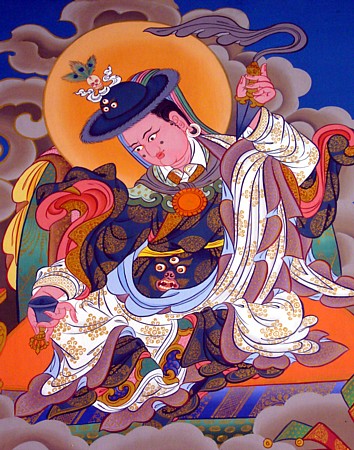Düpa Do: Difference between revisions
Jump to navigation
Jump to search
No edit summary |
RyanJacobson (talk | contribs) No edit summary |
||
| (13 intermediate revisions by 5 users not shown) | |||
| Line 1: | Line 1: | ||
[[Image:Sangye Yeshe.jpg|frame| | [[Image:Sangye Yeshe.jpg|frame|[[Nupchen Sangyé Yeshé]]]]'''Düpa Do''' (Tib. འདུས་པ་མདོ་, [[Wyl.]] ''‘dus pa mdo''), '''Do Gongpa Düpa''' (Tib. མདོ་དགོངས་པ་འདུས་པ་, Wyl. ''mdo dgongs pa ‘dus pa''), ''The Sutra which Gathers All Intentions'' — the principal text of the [[Anuyoga]], which is part of the [[kama]] tradition. It consists of 75 chapters and was translated from the language of Gilgit by Chetsun Kyé, a native of Gilgit, in the late 8th or early 9th century. The Anuyoga [[tantra]]s were brought to Tibet by [[Nupchen Sangye Yeshe]]. The [[sadhana]] corresponding to this tantra is the ''Tsokchen Düpa''. | ||
==Commentaries== | ==Commentaries== | ||
*[[Nupchen Sangye Yeshe]] (9th century) wrote ''Armour of Darkness: A Commentary Explaining the Difficult Points of the Sutra Which Gathers the Intentions of All the Buddhas (Düpa Do)'' (Wyl. sangs rgyas thams cad kyi dgongs pa 'dus pa mdo'i dka' 'grel mun pa'i go cha lde mig gsal byed rnal 'byor nyi ma) (Tib. སངས་རྒྱས་ཐམས་ཅད་ཀྱི་དགོངས་པ་འདུས་པ་མདོའི་དཀའ་འགྲེལ་མུན་པའི་གོ་ཆ་ལྡེ་མིག་གསལ་བྱེད་རྣལ་འབྱོར་ཉི་མ་ཞེས་བྱ་བའི་སྨད་ཆ་བཞུགས་སོ།) | |||
*[[Katok Dampa Deshek]] (1122-1192) wrote several commentaries | *[[Katok Dampa Deshek]] (1122-1192) wrote several commentaries | ||
*[[Rigdzin Pema Trinlé]] (1641-1717) wrote an explanation of the [[empowerment]]s of Düpa Do at the request of the Great [[Fifth Dalai Lama]]. | *[[Rigdzin Pema Trinlé]] (1641-1717) wrote an explanation of the [[empowerment]]s of Düpa Do at the request of the Great [[Fifth Dalai Lama]]. | ||
*[[Lochen Dharmashri]] (1654-1717) wrote a ''‘dus pa mdo skor gyi yig cha''. | *[[Lochen Dharmashri]] (1654-1717) wrote a ''‘dus pa mdo skor gyi yig cha''. | ||
*[[Khenpo Nüden]] wrote a ''dgongs ‘dus ‘grel chen''. | *[[Khenpo Nüden]] wrote a ''dgongs ‘dus ‘grel chen''. | ||
*[[Khenpo Ngakchung]] wrote a ''‘dus pa mdo’i bsnyen yig''. | *[[Khenpo Ngakchung]] wrote a ''‘dus pa mdo’i bsnyen yig''. | ||
==Further Reading== | ==Further Reading== | ||
*[[Dudjom Rinpoche]], ''The Nyingma School of Tibetan Buddhism, Its Fundamentals and History'', trans. and ed. Gyurme Dorje (Boston: Wisdom Publications, 1991), the story of the transmission of this text is given throughout ''History'' (Book Two), Part Five; also read Part Seven, 'Ch. 3 ''Response to Critics of the Sutra which Gathers All Intentions'''. | |||
*Jacob Dalton, ''The Uses of the dGongs pa 'dus pa'i mdo in the Development of the rNying-ma School of Tibetan Buddhism'', University of Michigan, 2002 | *Jacob Dalton, ''The Uses of the dGongs pa 'dus pa'i mdo in the Development of the rNying-ma School of Tibetan Buddhism'', University of Michigan, 2002 | ||
*Jacob Dalton, ''The Gathering of Intentions: A History of a Tibetan Tantra'' (New York: Columbia University Press, 2016). | |||
[[Category:Texts]] | [[Category:Texts]] | ||
[[Category:Tantras]] | [[Category:Tantras]] | ||
[[Category:Anuyoga]] | [[Category:Anuyoga]] | ||
Latest revision as of 14:39, 3 December 2024

Düpa Do (Tib. འདུས་པ་མདོ་, Wyl. ‘dus pa mdo), Do Gongpa Düpa (Tib. མདོ་དགོངས་པ་འདུས་པ་, Wyl. mdo dgongs pa ‘dus pa), The Sutra which Gathers All Intentions — the principal text of the Anuyoga, which is part of the kama tradition. It consists of 75 chapters and was translated from the language of Gilgit by Chetsun Kyé, a native of Gilgit, in the late 8th or early 9th century. The Anuyoga tantras were brought to Tibet by Nupchen Sangye Yeshe. The sadhana corresponding to this tantra is the Tsokchen Düpa.
Commentaries
- Nupchen Sangye Yeshe (9th century) wrote Armour of Darkness: A Commentary Explaining the Difficult Points of the Sutra Which Gathers the Intentions of All the Buddhas (Düpa Do) (Wyl. sangs rgyas thams cad kyi dgongs pa 'dus pa mdo'i dka' 'grel mun pa'i go cha lde mig gsal byed rnal 'byor nyi ma) (Tib. སངས་རྒྱས་ཐམས་ཅད་ཀྱི་དགོངས་པ་འདུས་པ་མདོའི་དཀའ་འགྲེལ་མུན་པའི་གོ་ཆ་ལྡེ་མིག་གསལ་བྱེད་རྣལ་འབྱོར་ཉི་མ་ཞེས་བྱ་བའི་སྨད་ཆ་བཞུགས་སོ།)
- Katok Dampa Deshek (1122-1192) wrote several commentaries
- Rigdzin Pema Trinlé (1641-1717) wrote an explanation of the empowerments of Düpa Do at the request of the Great Fifth Dalai Lama.
- Lochen Dharmashri (1654-1717) wrote a ‘dus pa mdo skor gyi yig cha.
- Khenpo Nüden wrote a dgongs ‘dus ‘grel chen.
- Khenpo Ngakchung wrote a ‘dus pa mdo’i bsnyen yig.
Further Reading
- Dudjom Rinpoche, The Nyingma School of Tibetan Buddhism, Its Fundamentals and History, trans. and ed. Gyurme Dorje (Boston: Wisdom Publications, 1991), the story of the transmission of this text is given throughout History (Book Two), Part Five; also read Part Seven, 'Ch. 3 Response to Critics of the Sutra which Gathers All Intentions'.
- Jacob Dalton, The Uses of the dGongs pa 'dus pa'i mdo in the Development of the rNying-ma School of Tibetan Buddhism, University of Michigan, 2002
- Jacob Dalton, The Gathering of Intentions: A History of a Tibetan Tantra (New York: Columbia University Press, 2016).